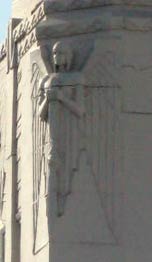|
The Grand Central Air Terminal (GCAT) was an early hub of air transport and private flying in the Los Angeles area. An interesting non-technical overview of the airport is provided at this link by the City of Glendale, CA. This artistically-done piece is a combination of slide show, animation and texts with photographs and drawings.
Below, this photograph dates from before ca. 1927. This photo is part of the Elmer C. McLeod Photograph and Document Collection on this site.
Grand Central Air Terminal Before the 1929 Upgrades (Source: McLeod Collection)
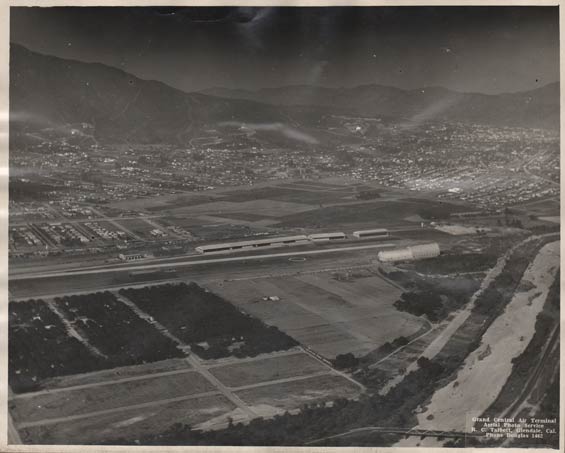 |
Note the Los Angeles River at lower right. The terminal building does not have a tower like the new one shown below. The dome-shaped buildings, center right, are the hangars of the Slate Dirigible Company. An excellent summary of the Slate Dirigible Company business is at the link, with many photographs. The caption at lower right of this photo is the identification of the aerial photography company, based at GCAT, that took the photograph.
Chances are a lot of Register pilots who cited their home base or destination as "Los Angeles" were referring to GCAT. It was the first official air terminal for Los Angeles. In its heyday, it hosted many air transport companies, including Gilpin Air Lines, Maddux Airlines and Transcontinental & Western Airlines (TWA). GCAT offered hangars and services to thousands of transient pilots, many of whom passed through Tucson.
Grand Central Air Terminal, 1933
(Source: Webmaster)
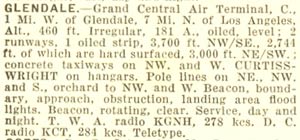 |
At right, from the book "Airports and Established Landing Fields in the United States, 1933" (cited, left sidebar) is a listing of data for the airport in that year. It had two runways on 181 acres. The runway at center is the one with 2,744 feet of hard-surface, which surface is is visible toward the lower right corner of the photograph below.
Notice that TWA (as well as Gilpin) was operating on the field in 1933. Just a few years before, TWA had purchased Standard Air Lines from Register pilots Jack Frye and Paul Richter. Follow their links for further information about Standard and its traffic through Tucson.
Image, below, dated July 19, 1930, from the collection of Tim Kalina. Compare the data, above, with this photograph.
Grand Central Air Terminal, Glendale, CA, 1930
(Source: Kalina)
 |
Parachute Jump Over Grand Central, November 9, 1929 (Source: Lane)
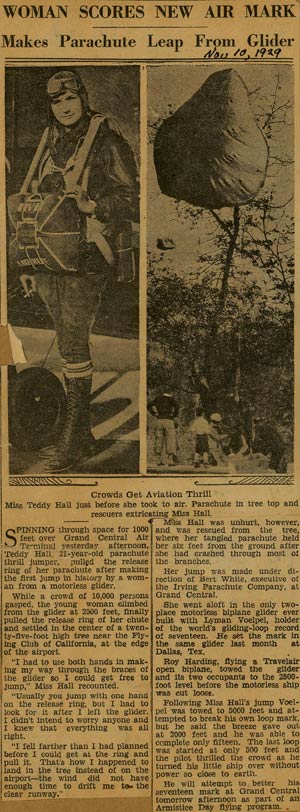 |
The photo above is what the airfield looked like to Edith "Teddy" Hall, a 22-year-old parachutist who jumped from a glider over the airport on November 9, 1930. Her son, Mr. Lane, shares the news articles at left and below with us, and informs us that her age, contrary to the 20 & 21 years cited in the news articles, was 22. The article, left, is also misdated; the actual year being 1930.
Parachute Jump Over Grand Central, November 9, 1929 (Source: Lane)
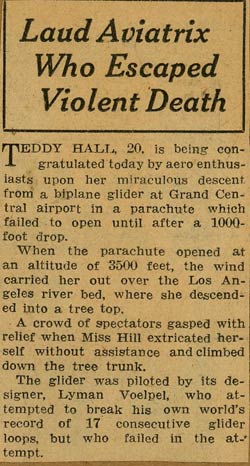 |
Characteristic of a lot of journalism of the era, these articles focus on the sensational.
Parachute Jump Over Grand Central, November 9, 1929 (Source: Lane)
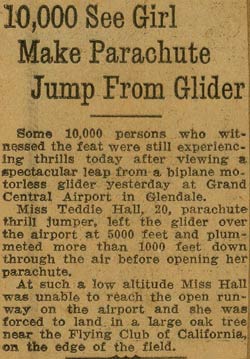 |
Interestingly, in the article above are mentioned Bert White, who passed through Tucson as a passenger with Pancho Barnes, and Roy Harding a Register pilot who landed at Tucson six times. He flew two different Travel Airs to Tucson, NC631H and NC6283. It is not clear from the article, or from his Register data, if his tow plane was one of them. I'm looking for information about pilot Harding, if you can HELP.
A video of a contemporary news film of Ms. Hall's jump is available at the University of San Diego Bookstore. It is DVD #19. The video is annotated, "1930/11/13 Girl Sets Record In parachute Leap From Looping Glider - Glendale CA: 'Pretty Teddy Hall, 20, hops off Lyman Voelpel's motorless biplane when almost a mile high and drops like a bullet for 1000 feet before her parasol opens. As groundlings gasp in horror, she floats down 3500 more feet to plump in a tree-top, which she evacuates pronto and scathless.'"
Mr. Lane says further about his mother, "She was born 16 April 1908 as Edith Evelyn Weaver. Early in her life she picked up the nickname Teddy. She married William 'Bill' Hall on 9 April 1927. Another interesting fact that you may be interested in is that William was killed when his parachute ripped open during a delayed opening jump at Burnley Airport in Pomona on 31 July 1929. He was well known in LA area as a pro golfer and jumper. He was also manager of a Eureka Vacuum Cleaner [distributorship]. He used to jump with a cleaner and open the bag on the way down, causing promotion leaflets to float down on the crowd."
Clearly, GCAT has a glamorous and enrolling history. It became an official airport entity as Glendale Municipal Airport on March 17, 1923. It was given a name change of Grand Central Air Terminal and rededicated February 22, 1929. The beautiful terminal building (see below) was under construction, about half-way completed, at the time of dedication. A good resource, which includes many period photographs, including the terminal building under construction, is John Underwood's informative book, cited in the left sidebar.
GCAT was scene of several movie shoots during the 1930s. It hosted several well-known movie personalities who owned aircraft and hangared them at Grand Central. Among them were Register pilots Roscoe Turner, who operated his short-lived Nevada Airlines business there, Wallace Beery and Ben Lyon. Although it played a major role in military aviation during WWII, it soon became encroached by its neighborhood after the war and it could not expand its runways enough to handle larger commercial transport aircraft. The airport dwindled and eventually closed operations in 1959.
Below, from 1937 (cited, left sidebar), is another edition of airport data published by the Department of Commerce (DOC), which governed things aeronautical in the United States at the time. Curiously, the DOC radio station, KCT, had changed its frequency from 284 kc to 260 kc. Little else had changed, except maybe the addition of a range radio that is not mentioned in 1933.
Grand Central Air Terminal, 1937
(Source: Kalina)
 |
Look closely at the terminal building at left in the 1930 photograph above and compare it to the ones below. The Grand Central Air Terminal building is still standing as of the upload date of this page. The color photographs that follow are courtesy of Cecile LaGue Alessi (credit, right sidebar). Because of her work, Ms. Alessi had access to the terminal in 1984 and in 2009 and took the photos she shares with us.
The first photograph is of the terminal exterior from the west side. Compare these following four photographs taken in 1984 with the ones further down taken in 2009. While most of the facade remained the same over 25 years, the windows are boarded over and fences erected in the later views. The view, below, is from the southwest.
Grand Central Air Terminal, 1984 (Source: Alessi)
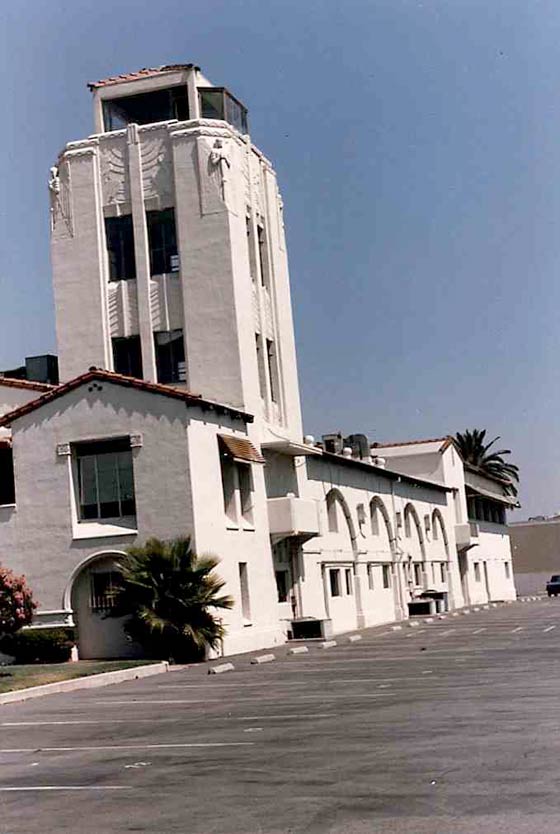 |
Next, the tower from the north side.
Grand Central Air Terminal, 1984 (Source: Alessi)
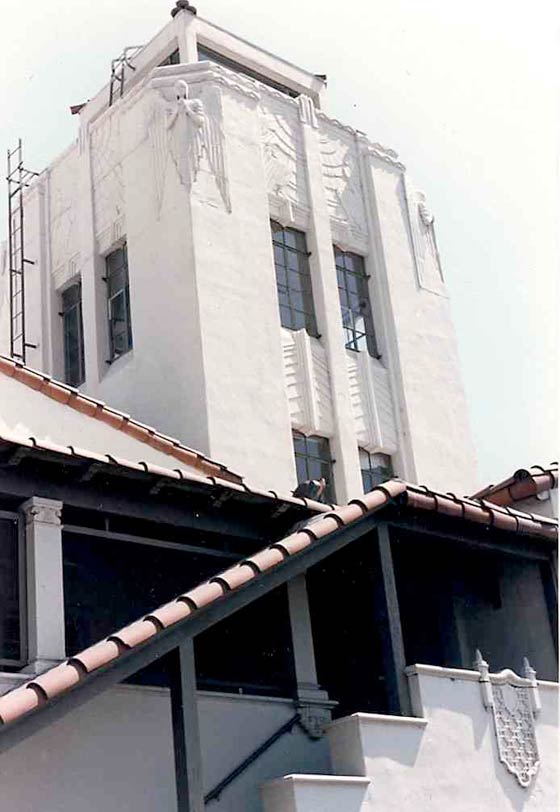 |
Next, the west end.
Grand Central Air Terminal, 1984 (Source: Alessi)
 |
Below, a collage of interior views of the terminal in 1984. Note the Art Deco (Moderne) accents, the volume of the space, and the clean lines of the mezzanine. The ceiling tiles and fluorescent lights are not, of course, original. Ms. Alessi says about these images, "I took most of the pictures from the 2nd floor walkway...looking north and south along the inside. Interior stairs are on the south end of the building."
Grand Central Air Terminal, Interior, 1984 (Source: Alessi)
 |
Last, detail of a drawing, perhaps dating from the Golden Age, which still hung on the wall of the terminal in 1984.
Grand Central Air Terminal, Art Work, 1984 (Source: Alessi)
 |
The airplane, a Ford trimotor in TWA livery, is not among the 62 landings by Fords that appear in our Register.
Further, below are three photographs taken July 25, 2009 by Ms. Alessi. These views would be from the far eastern end of the building as it stands in the 1930 photo, above.
Grand Central Air Terminal, July 25, 2009 (Source: Alessi)
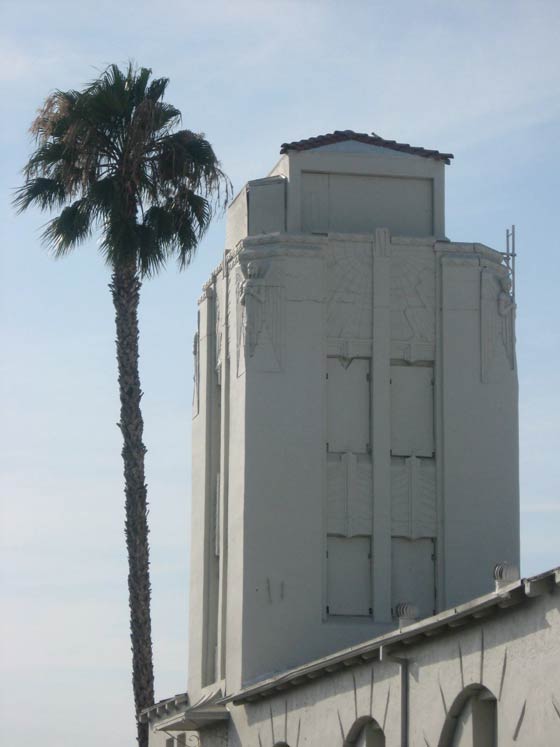 |
The property and building belong now to the Disney company. There is rumor that the building will be restored to its original configuration when it was an active air terminal. Below, long view from the southeast.
Grand Central Air Terminal, July 25, 2009 (Source: Alessi)
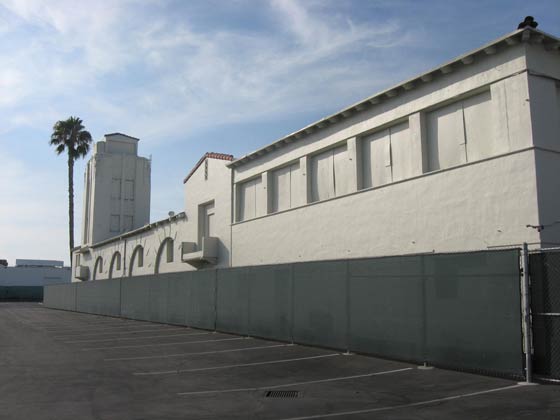 |
Below, detail from the southeast of the Art Deco tower sculptures. The figures (detail, right sidebar) are stylized human forms with wings, wearing flying helmets.
Grand Central Air Terminal, July 25, 2009 (Source: Alessi)
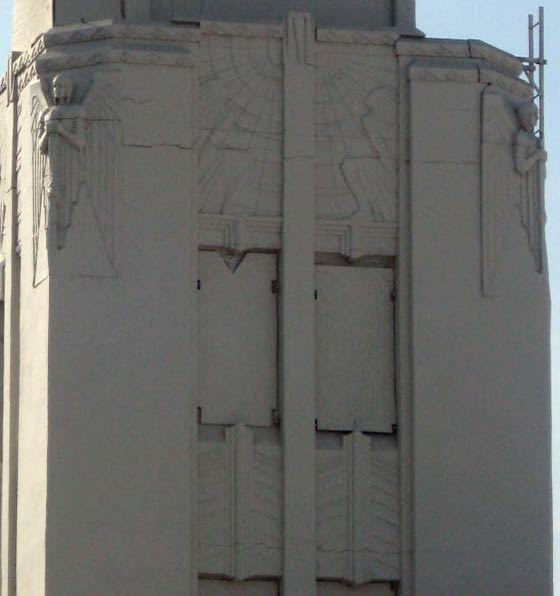 |
Finally, Google Earth offers the following overhead view of the terminal. The fence of 2009 appears to be gone. North is toward the top of this image.
Grand Central Air Terminal, January, 2010 (Source: Google Earth)
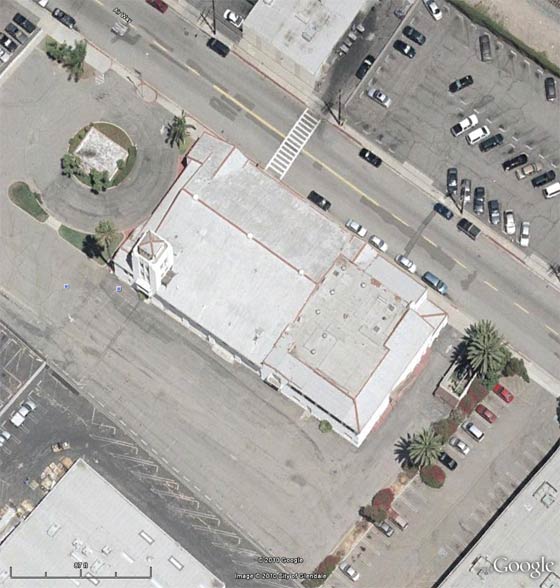 |
---o0o---
Update of 07/05/10 Below are three video segments available on YouTube. They are serial continuations of the same video, "When Glendale Ruled the Skies." The video nicely segues back and forth between contemporary views of the Terminal and views from the 30 years of its life between February 22, 1929 and July 15, 1959. Abbreviated credits are at the end of Part 3.
At the link is Part 1, 10 minutes and 30 seconds. The earliest history of aviation is summarized in the Glendale/Los Angeles area. Register piilots Amelia Earhart, Charles Lindbergh are identified. Two Register aircraft, GeeBee NC46V and the Ryan NYP NX211, "The Spirit of St. Louis," are identifiable. This Part ends with views of the Terminal under construction.
Part 2 follows at the link. Register pilots Lindbergh and Earhart are shown. Excellent reviews and photographs of the Terminal interior and operation are provided. Register passengers Mr. & Mrs. Jack Maddux are identified. Maddux Air Lines and the first plane/train cross-continent service are highlighted. American Airlines Curtiss Condors are shown, with commentary by Shirley Temple. Ford trimotors NC9651 and NC9639 are identifiable in TAT and Maddux livery at about 6:22 and 6:39, respectively, in the film. Refer to the links to learn about their arrivals at GCAT and Tucson.
Part 3 follows at the link, 8 minutes. The role of the Terminal in movie making is highlighted. We see exterior and interior shots of "The Good Ship Lollipop." Register pilots Lindbergh, Earhart, Pancho Barnes (pictured in a still photo), Jimmy Doolittle and Wiley Post are mentioned. Visible at 5:45 in the film are the Stearman NR882N, and Richard Halliburton and Moye Stephens (R) flank Pancho Barnes. The roles of GCAT during WWII and post-war, as well as its final closing on July 15, 1959, are covered.
---o0o---
Update of 11/19/16 The Grand Central Air Terminal building has been restored by the Disney company as of February, 2016. Follow the link for photos of the restoration. A look at Google Earth on November 19, 2016 showed that their photography has not yet caught up with the complete restoration. A street view shows the facade still under reconstruction, complete with scaffolding.
Ford NC9651 at GCAT, Date Unknown (Source: Link)
 |
This wonderful, historic building has been brought back to life through a thoughtful and accurate restoration by the Disney company. We should all be happy about that.
Update of 12/03/17 Another YouTube video shows briefly at the link the Ford trimotor NC9651 landing and taxiing at GCAT. Look near the end of the video. The photograph, right, is a still image from the video. You can read about NC9651 on the GCAT Web site at the link.
---o0o---
THIS PAGE UPLOADED: 02/22/07 REVISED: 01/25/10, 07/05/10, 05/07/11, 11/19/16, 12/03/17
|



















